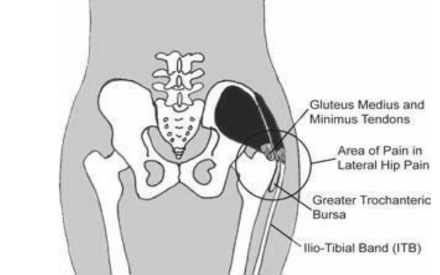Lateral Hip Pain
What is Lateral Hip Pain?
Lateral hip pain is usually caused by the tendons (the part that connects muscle to bone) and muscles becoming sensitive and irritable.
Occasionally, it can also be caused by the bursa of the hip becoming swollen. The bursa is a fluid filled pad that acts as a cushion to reduce friction between tissues.

Who might get Lateral Hip Pain?
Lateral hip pain most commonly develops in people who are very active because the tendon becomes ‘overloaded’ and people who are sedentary because the tendon is not used enough. However, it can also be caused by spending time in positions that stretch or compress the tendon or following a fall or a trauma.

The condition is also common in peri or post-menopausal women between 40 and 60 who have a sedentary lifestyle or experience a significant change their activity levels. Hormone changes during menopause, smoking, diabetes and being overweight can also increase the chances of developing the condition.
What are the most common symptoms?
- Pain on the outside of the hip. This is often quite localised but the pain can sometimes track down the side of thigh
- Pain when sleeping
- Pain when standing on one leg, for example when getting dressed
- Pain when sitting for long periods of time (especially cross legged) and while walking up and down stairs
- Hips feeling stiff and painful during the first few steps in the morning or after a long period of rest, but ‘warms up’ with movement
How is it diagnosed?
Often a detailed history of your symptoms and clinical examination is sufficient to diagnose a Lateral hip pain. Also examining your range of movement, strength and some more specific tests are will help to further confirm the diagnosis.
What are the treatments?
In the early stages, reducing strain on the sensitive tendons is usually enough to settle the symptoms. For example:
- When standing, avoid leaning on one side. Try to spread your weight evenly
- Avoid sitting with your legs crossed, or with your legs spread far apart.
- When sleeping, consider sleeping on your back or on the non-painful side with a pillow resting between your knees.
- Avoid standing on one leg to get dressed
Once symptoms start to improve it is important to gradually begin using and strengthening the tendons again.
Exercise is the main treatment for tendons and has good results. Please see below for a list of exercises to try.

Other treatments can include:
- Heat / ice
- Weight loss – Please see the Keeping Me Well Weight Management page for more advice and to self-refer to the Weight Management Service.
- Shockwave Therapy — A treatment to stimulate the tendons natural healing process and help with tendon pain relief
Exercises
Exercising with a little bit of pain is ok and it doesn’t mean you’re damaging the tendons. However, if pain that remains for hours or continues into the next morning, you might be doing a bit much and should reduce the volume.
These exercises can be done daily:

- Hold on to the kitchen counter or the back of a chair
- Keep your hips level and take your pain free leg off the ground.
- Hold for 5 to 10 seconds and gradually build up the time to 45 seconds as pain reduces.
- Repeat 4 to 5 times daily.

- While sitting with a resistance band or a belt around both knees or using your hands to resist, push your knees out sideways
- Hold for 5 to 10 seconds.
- Gradually build up to 45 seconds as pain reduces.
- Repeat 4 to 5 times daily.
 Lying on your back, bend your knees and keep your feet flat on the floor.
Lying on your back, bend your knees and keep your feet flat on the floor.- Gently squeeze your stomach and bottom muscles.
- Slowly lift your bottom off the bed to a comfortable range and then return to start.
- It doesn’t matter how much you lift your bottom at this stage as this can be improved over time.
- If you are feeling the exercise more on the back of your thigh, you may find it useful to bring your heels slightly closer to your bottom.
- Aim to do 10 repetitions of two or three sets times daily.
If you don’t find there is a change in your symptoms after activity modification and trying the above exercises, speak to a GP or Physiotherapy for a specific assessment and guidance.
Useful Links
More information and guidance on all aspects of health and healthcare can be found below on the NHS or CSP Physiotherapy websites to help you to manage your condition and inform your choices about your health.

